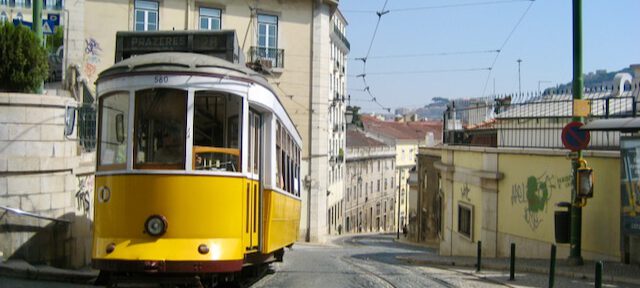Question:
I have just visted Lisbon and did a tourist tram ride. I have spent the last couple of days trying to find details of how the trams manage the very steep hills as the slopes are much steeper than I would expect. Can you signpost any internet sights for me.
Answer:
I’m not sure about information on the internet about this. That the small Lisbon tramcars can tackle the hills is because of a combination of things:
1) The motors are quit powerful. The current trams (series 541-585) have 2×50 kW motors, which means about 6.7 kW/ton for a fully loaded tramcar. Also both axles are powered. The modern articulated trams which do only service on line 15, have 2×105 kW, but as they are much larger, they have about 5 kW/ton for a fully loaded tramcar with 4 out of 6 axles powered.
2) Sand. To avoid slipping of the wheels sand is poured on the rails. On the most critical places evidence for the use of sand can always be seen.
3) No trees. In Porto is a long 7% gradient under the trees. Often in the autumn period with humid weather, leaves and other dirt falls on the rails and the trams struggle to climb because the rails becomes very slippery. The same trams with the same drivers on the same days have no problems on the 10% gradients downtown. No trees there, which means the rails doesn’t become slippery. In Lisbon are no trees on the most critical places. Likely more a matter that there was no space for trees in the first place than that they were removed because of the trams.
4) The winter climate is soft because of the nearby ocean. There is never snow or freezing rain.
5) Although not important for ascending, but very important to avoid uncontrolled descending, the trams have four independent operating brake systems: highly-rated rheostatic brake, battery operated electromagnetic track brake, air brake and handbrake.
6) Driver training. When Lisbon still had a large network, operations were divided to flat lines and hilly lines. On the first mainly single operating large bogie trams and small 2-axle trams combined wit 2-axle trailers were used. On the hilly routes only single operating small 2-axle trams were used, which were equipped with extra brake systems. While all drivers could work on the flat lines, on the hilly lines only drivers with a special drivers license, which they got after successful extra training, were allowed to work. Nowadays only line 15 is flat, but I believe that new drivers will start there and only after having enough experience, they will start with extra driver training for the other lines.


Leave a Reply